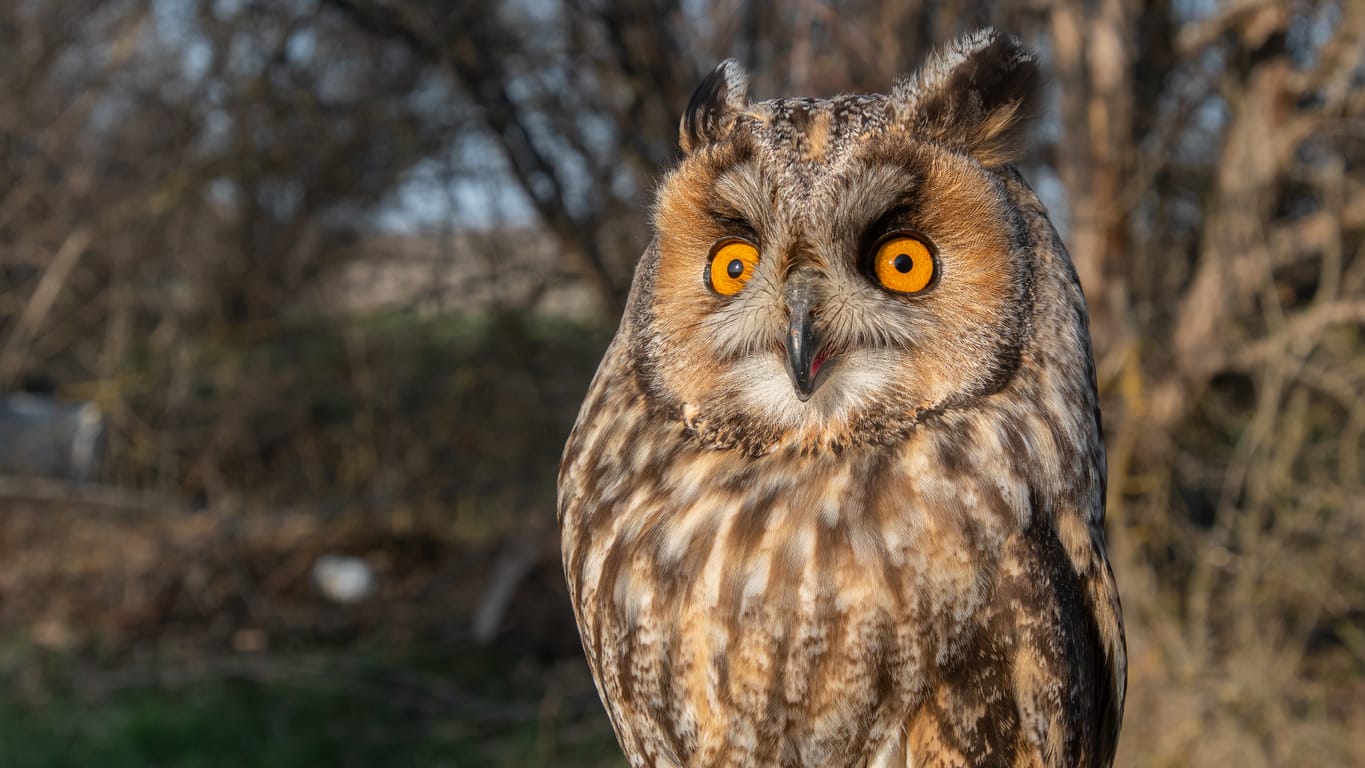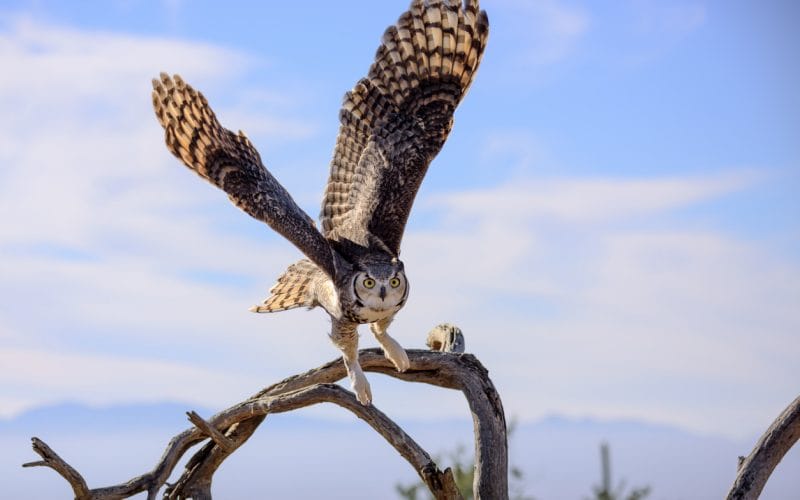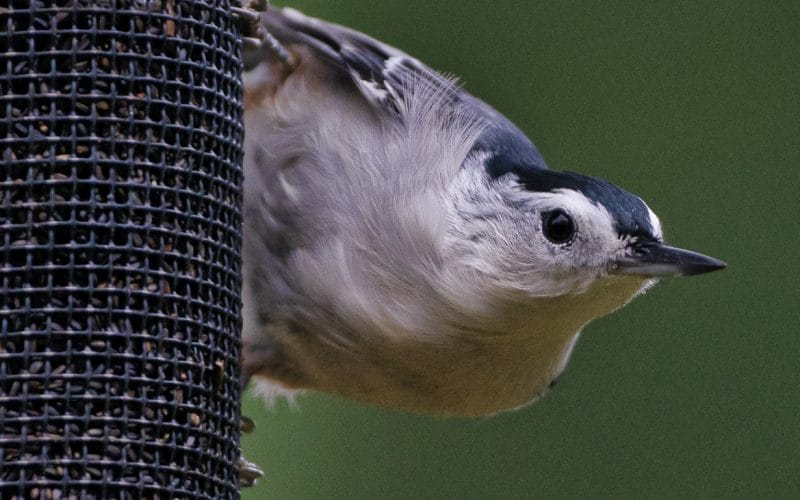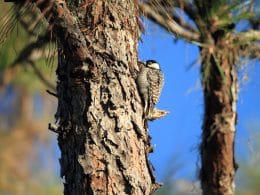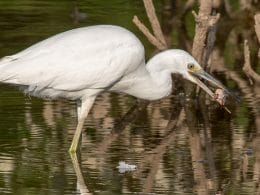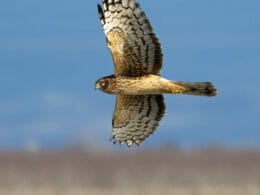Michigan is home to nearly 20 million forestland acres, making it the closest thing to heaven for owls. More than half of its land is covered in greenery, and it contains more than 14 billion trees. You know, some entire countries don’t have half the amount!
Whether you’re visiting one of Michigan’s 103 state parks, living in the state, or simply want to know more about its owls, I’ll list the 11 species you can see there.
The United States has 19 species, and you can see 11 of them in Michigan. Here’s a roundup of them.
11 Species of Owls in Michigan
Michigan has an exciting variety of owls. Between the scary Great Horned Owl and the adorable Northern Saw-whet, the state has got itself a pretty good variety. Here’s a brief overview of every owl, its unique characteristics, and where you can find it.
1. Barn Owl

Barn Owls gained their name because they like to build their nests in abandoned barns. They also have the nickname ‘ghost owls’ because they have white faces that appear like ghosts in the dark.
These owls mostly live in woodland edges and farmlands. They like to hide inside tree holes, and many of them are seen inside cliff crevices, trying to take nests abandoned by other birds.
Barn Owls are more common in south Michigan. If you’re lucky, you’ll see them during the flight. They have a distinctive flying pattern, gliding low, closing off to the ground to find their prey. When they’re not hunting, they’re rounding their nests or perching on high trees.
These owls don’t have a hooting sound like most owls in Michigan. Instead, they produce a shrill call, sounding more like a screech.
2. Barred Owl

With their hollowed-out faces and hostile feelings towards humans, Barred Owls are meant to be feared. They’re best known for their aggressive behavior against humans; they won’t hesitate to attack someone’s hands, face, or head if they feel threatened. Unfortunately, their aggressive behavior also gets worse during the mating season.
Author Note: These scary fellas are often used as indicator species because of their sensitivity to habitat loss. Their behavior reflects biological changes of ecosystems, so experts gauge them to look out for environmental changes.
You’ll find Barred Owls in Michigan for the whole year. They stay in the state’s mixed woodlands, looking for birds and small mammals to prey on. Their hunting activity surges in the night when they stand silent on perches, waiting for the target to appear.
3. Long-eared Owl
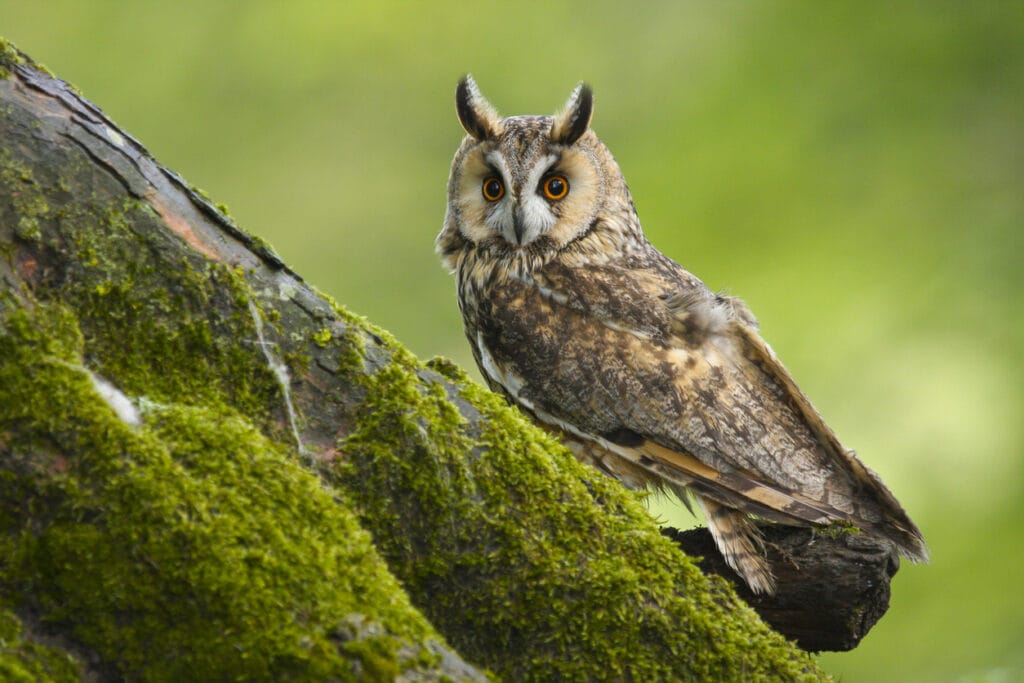
Long-eared Owls live in Michigan for the whole year, but that’s mainly in the central and south regions of the state. Those that live in the north only stay in the state for the summer.
These fellows look a bit like Great Horned Owls, thanks to their long ‘ears.’ However, they’re much smaller, and they’re not half as scary.
Long-eared Owls mostly live in woodland and forests, and they love areas with dense vegetation. So you can find them in orchards, shrublands, and parks, and they also —for some reason—love staying in cemeteries.
Like most owls, long-eared ones like to take the abandoned nests of other birds. However, they may also build their nests on the ground, which isn’t typical among owls.
If you want to see Long-eared Owls, you may not have much longer. Their numbers are constantly declining because of habitat loss, and it’s not clear whether they’ll re-surge.
4. Northern Hawk-Owl
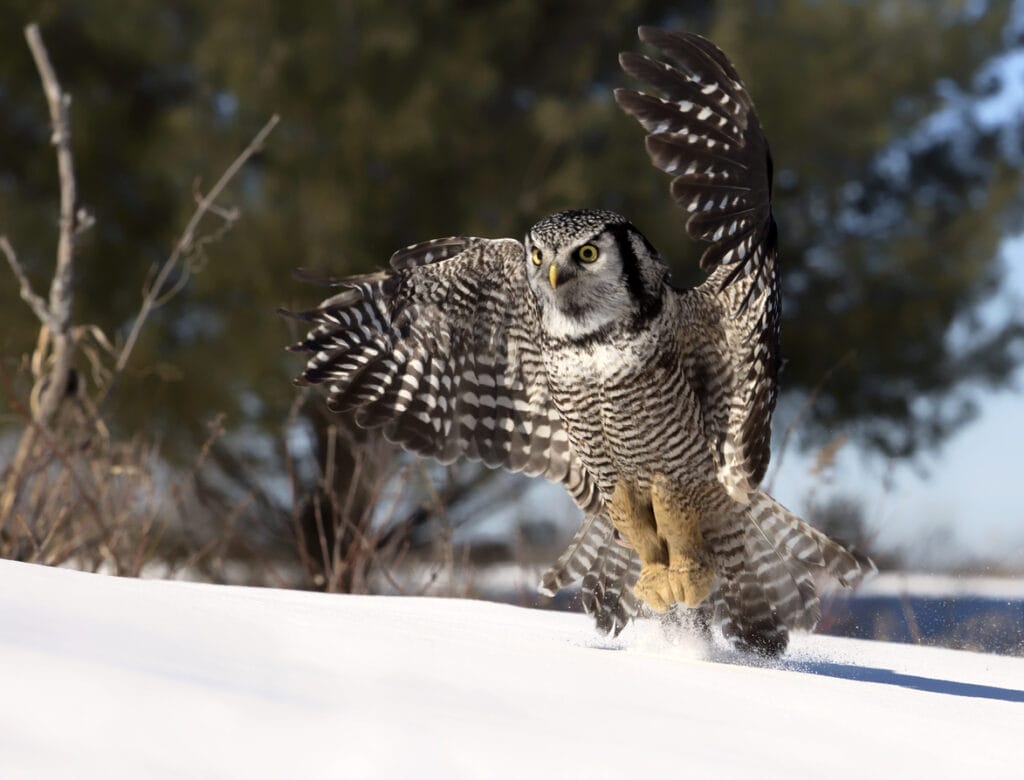
Northern Hawk-Owls are named after another species of birds because they don’t act as owls. Their behavior is closer to that of hawks, and they even look like them.
Top Tip: You may find it interesting that Northern Hawk-Owls are the last surviving species of the Surnia genus. The other species are now fossils, but our fellow here is doing good up till now.
Hawk-Owls have weird interests. They like to live in locations previously disturbed by fires, and they build their nests in boreal forests. They’re rare in Michigan, but some people reported seeing them up north. They hunt in the morning, so you may get lucky.
5. Short-eared Owl

Short-eared Owls have that name because they have tiny tufts on top of their heads. You won’t even see them except if you look from a bird-eye view or look up close.
Although these owls are small, they have multiple tricks up their sleeves. They protect their nests from predators by defecating on the eggs. That way, the smell keeps predators away, and the eggs remain safe.
Short-eared Owls have yellow eyes, surrounded by circles of black. They have a mottled brown plumage that helps them hide in dense vegetation.
During the breeding season, these owls stay in northern Michigan. They also appear in the state’s other regions during the winter—mainly in grasslands and open fields. You’ll find them flying like bats, with their wings flapping vigorously.
6. Great Horned Owl

The Great Horned Owl is classified as one of the scariest birds around the globe, and it’s no wonder. The owl is too large for its own good, and its yellow eyes glare right into your soul.
But that’s not the reason for the classification. Instead, the attacks caused by the owl are the main reason; it’s been known to attack hitchhikers and campers, resulting in death in some cases.
The owl has that name because of the two large tufts on top of its head. They look like horns, hence the naming. It has a grayish-brown plumage, helping it blend secretly into the dark of the night.
Great Horned Owls need to stay in open areas to find animals to hunt. So they build their nests anywhere they see fit, whether it’s an animal den, tree hole, or even an abandoned human-made house.
Additionally, these owls don’t migrate, so you’ll find them in Michigan for the whole year. If you want to see them, look near forest edges and woodlands.
7. Northern Saw-whet Owl
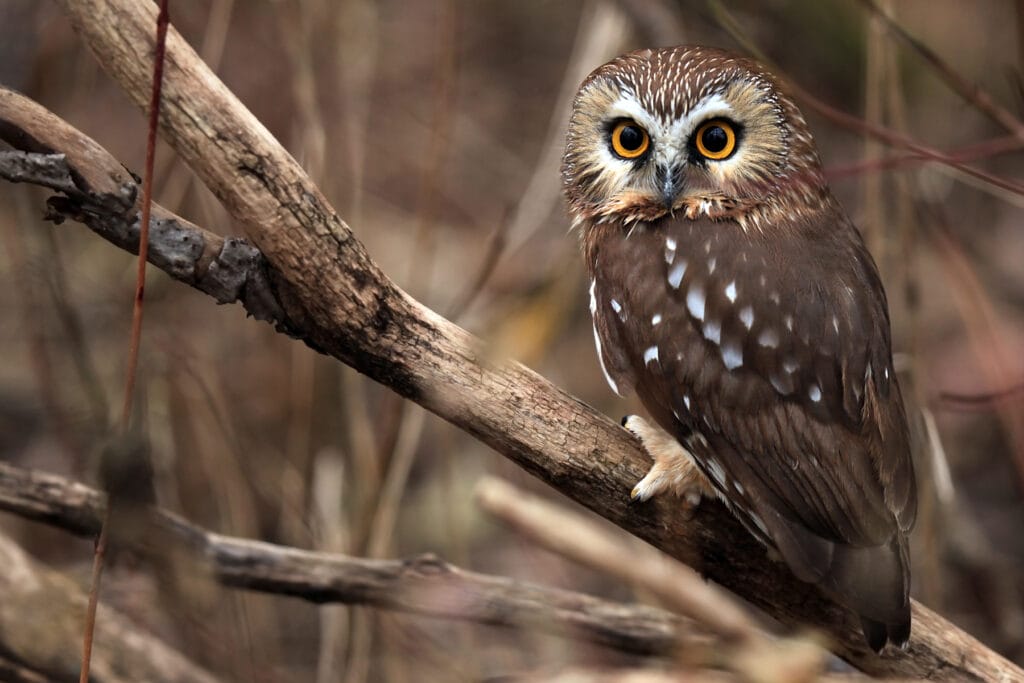
Northern Saw-whet owls are small, adorable, and beautiful. They’re basically the opposite of everything we know about owls. Their heads are large relative to their bodies, and their most distinctive feature remains their round yellow eyes.
These small owls live in coniferous forests and mixed woodlands, looking for tree holes abandoned by woodpeckers. They prefer stealing old nests over building their own.
In Michigan, you can see Northern Saw-whets all year long, but they’re more common in the northern regions. Despite their high numbers in the state, they’re a bit tricky to spot because they hide well.
You can wait for their call, which sounds like whistles. It’s a toot call that sounds like a saw cutting through a whetting stone, hence their name.
8. Eastern Screech-Owl

Eastern Screech-Owls have rusty brown bodies with white streaks all over. They have small tufts on top of their heads, making them look similar to short-eared owls.
These owls mostly live in mixed woodland, parks, deciduous forests, and orchards. They stay in Michigan for the whole year, and they pose no threat to humans. They even choose suburban areas to keep their nests, and they’re okay with humans around.
If you want to catch an eastern screech owl, look for it in nest boxes and cavities.
9. Great Gray Owl
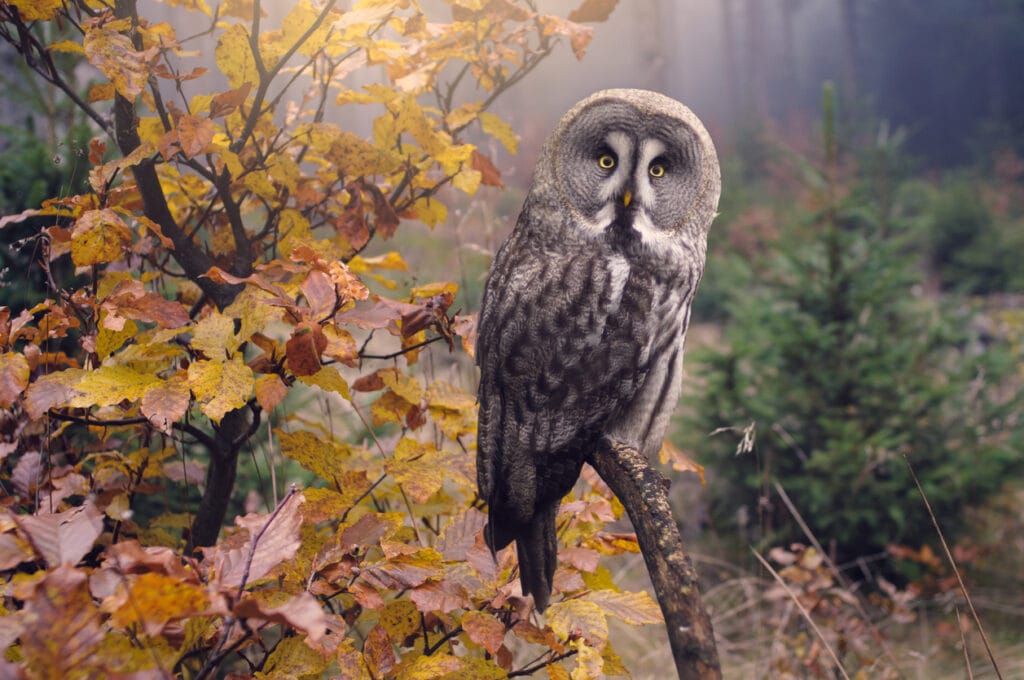
The most distinctive feature of Great Gray Owls is their size. They’re classified third among the largest owls in the world, beating snowy owls by a close shot.
These fellows have gray bodies with dark streaks, and their eyes are bright yellow, surrounded by dark circles.
Author Note: Great Gray Owls love hunting in open areas, and they mostly build their nests in coniferous forests. Your best chance of seeing them is in Michigan’s Upper Peninsula, but they don’t like to make their presence known.
So even if they’re around, they may not appear.
10. Snowy Owl

Do you remember Hedwig from the Harry Potter series? That was a Snowy Owl. But don’t be tricked; Snowy Owls aren’t nearly as lovely as Hedwig was. In fact, they’re notorious hunters, and they’re known for their aggressive behavior against humans.
Snowy Owls are unmistakable; they don white bodies like no other bird. The females may have brown streaks on their feathers, but the owls are mostly white, helping them camouflage against the snow in the arctic.
These owls are most common in the Arctic tundra, but they come to Michigan during the winter. You may see them in grasslands, meadows, and lakeshores. They hunt both day and night, which is uncommon among owls. But nothing about Snowy Owls is common, anyway!
If you happen to see Snowy Owls, I recommend staying away from them; they’re known for attacking suddenly when they see humans around, resulting in deaths in some cases.
11. Boreal Owl
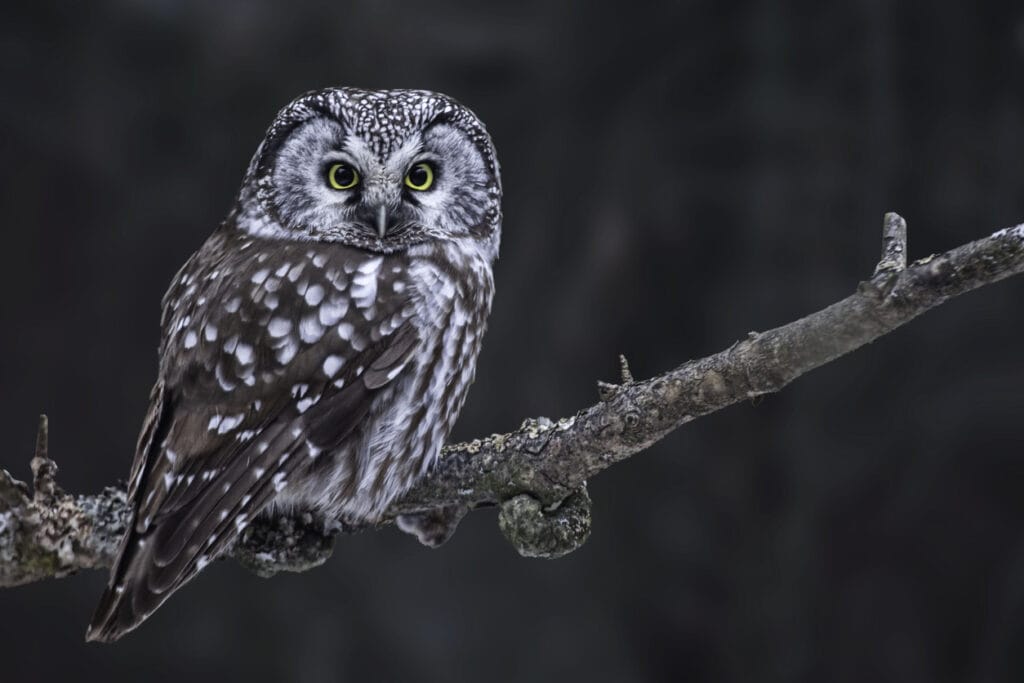
Boreal Owls have extra wide, round eyes, making them look like they have a permanently stunned expression. They’re generally shy, so you have low chances of seeing them, even if they’re abundant in your area.
Most of Michigan’s populations of Boreal Owls don’t migrate. Those that migrate move to the south when the weather gets too cold, but they stay within their breeding range.
Top Tip: If you want to see Boreal Owls, your best chance is looking in forests in the northern region, but as I said, they rarely make their presence known.
They’re also nocturnal, so they don’t appear during the day.
Other Popular Predatory Birds in Michigan
Owls aren’t the only prey birds that call Michigan home. There are a lot of other species, and if you’re as interested in predatory birds as I am, you’ll find this list exciting!
Peregrine Falcon
Peregrine Falcons are highly common in Michigan, and they’re best known for their wide yellow eyes. You won’t find any other bird that has the same large yellow eyes.
Luckily for bird watchers and unluckily for rodents and small birds, these falcons love to live in cities. They don’t live in the wild like most prey birds, but instead, they find comfort close to tall buildings and in city streets.
Do you know how cheetahs are called the fastest animals in the world? That’s only because Peregrine Falcons are letting them live the moment. Our notorious prey bird here can reach a whopping speed of 200 mph—better than a Ferrari F40 can!
The extraordinary speed gained Peregrine Falcons an easy place as the fastest flying animals in the world.
Red-Tailed Hawk
The Red-tailed Hawks are among the most common birds in Michigan. You’ll have a hard time identifying them because each hawk has a different plumage; the colors can range from white and all the way to black. They’re best known for their red tails.
Red-tailed Hawks adapt perfectly well to new places, so you can find them in virtually any habitat. They’ll live in city parks, urban streets, and even backyards.
Bald Eagle
Contrary to common belief, Bald Eagles aren’t called that because they’re bald. Instead, they gained their famous name because of their whiteheads. The white color makes them easy to identify, but that’s only when they’re grown up.
Until these eagles are five years old, they don’t get their distinctive white heads and brown bodies. Their plumages can be brown, black, white, or any similar color, so identifying them will be a bit tricky.
Around the ‘70s, Michigan only had 75 pairs of Bald Eagles. Now, the number surged to more than 800 pairs, making the bird among the most common in the state.
American Kestrel
American Kestrels are pretty capable of tricking their prey, using their small size to their advantage. They’re nearly the same size as American robins, being the smallest predatory birds in North America.
No self-respecting animal would suspect that these small fellas are predators, but that’s not how nature works.
American Kestrels are actually notorious hunters, and they’re known for hovering close to the ground, waiting for prey to appear. They’re also called sparrow hawks because of how easily they can hunt sparrows.
Sadly, the brilliant hunting skills don’t make the kestrels any safer than the sparrows they hunt. They’re often hunted down by large predators because of their small size.
The Takeaway
There are 11 species of owls in Michigan, and they’re all worth a trip to the Great Lakes state. You may get lucky and see a rare sight, like the Boreal Owl or the Northern Hawk-Owl.
If you’re not so lucky, you’ll see the aggressive fellas, like the Snowy Owl or the Great Horned one. Just stay away from them, and you should be good. You may also get the chance to take a couple of photographs!
FAQ
There are 3 relatively common owls in Michigan. They are the Great Horned Owl, Barred Owl and Eastern Screech-Owl.
The Great Horned Owl is a huge owl. It has a wingspan of nearly 1.5 meters.
The Short-eared Owl and the Saw-whet Owl are the smallest owls in Michigan. They both have a wingspan of a little less than half a meter.




